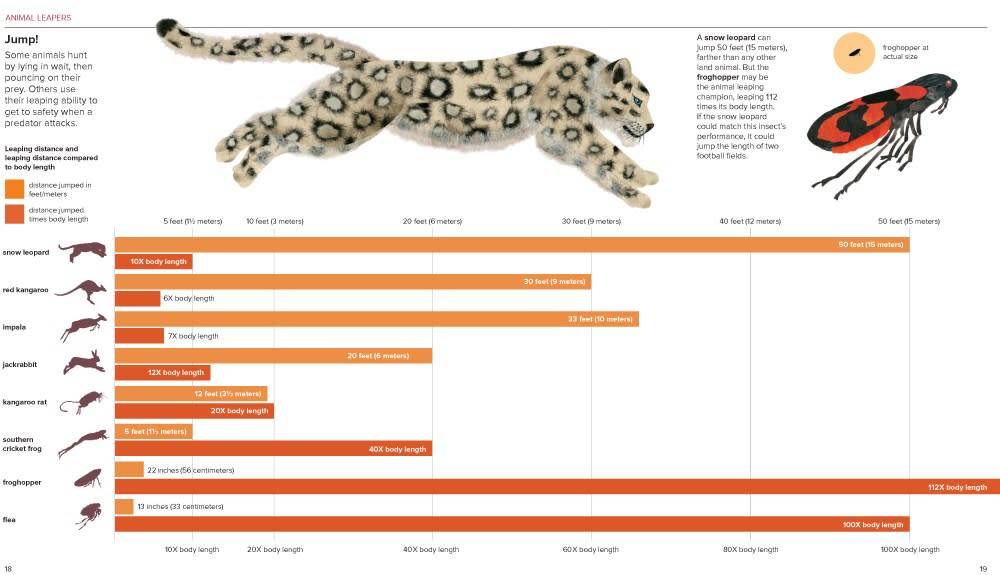Title: Animals by the Numbers: A Book of Animal Infographics
Author: Steve Jenkins
Publisher: HMH Books for Young Readers
Copyright: November 1, 2016
ISBN: 978-0544630925
Age Range: 6-9 Years or Grades 2-6
Reading Level: Lexile-940
Cost: $17.09
Pages: 48
SUMMARY: Animals by the Numbers is a book filled with infographics. Even the table of contents uses graphics to guide you to sections. Want to know which species dominates the globe? Well it is not mammals! Want to see how humans compare in size to the largest animals? Did you know the Cheetah is not the fastest creature on the planet? Who has the longest tongue on Earth? Did you know a giraffe only sleeps 2 1/2 hours a day? All of these facts and so many more can be found in this book. Of course you can find out most, if not all, of this information on the internet, but the use of infographics allows for easy comparisons of the species. The collage like graphics accompanying the charts adds whimsy and breaks up the monotony of the many charts. This book is filled with facts that are absolutely fascinating. Did you know the most deadly creature on the planet is the Mosquito?
CRITIQUE: Not only can youth learn a great deal about the animals around them, but they also can learn about creating infographics (charts, graphs, & pictographs). The title takes layers upon layers of facts and breaks them down into digestible, fun, and fascinating pictures. This is definitely a title that could be in every elementary classroom, not just in a library. The title received starred reviews from School Library Journal, Kirkus, and Booklist. It was the 2018 winner of AAAS/Subaru SB&F Prize for Excellence in Science Books.
"The intriguing and engaging format of this title is stimulating on a variety of levels, and the approach should appeal to a wide range of students, especially visual learners, something for which educators will be grateful. A brilliantly executed take on a perennially high-interest topic." --Booklist
FEATURES INCLUDED: The book includes a Table of Contents at the beginning and a Bibliography at the end with books/websites used. You can find out more books by Steve Jenkins at his website: www.stevejenkinsbooks.com
EXAMPLES:
This page highlights "Animal Leapers." Here like many other pages you can see more than one fact in a chart. You can see distance jumped in feet in relation to distance jumped times body length. While a snow leopard can leap up to 50 feet, a froghopper can leap up to 112x body length. Then at the top it compares the two in relation to one another.
On this spread we see the life spans of animals compared. P.S. humans are not chart topping! What is cool is that each color represents a different species. So again you can compare multiple things at once. On the right side it's all about heart, beats that is. Hummingbirds hearts beat at 1200 bpm compared to a blue whale at 10 bpm. Now check out the size of a blue whale's heart in comparison to the size of a child.
COMPARISONS/RECOMMENDED READING:
Steve Jenkins has so many wonderful book; however, Actual Size provides visual facts about animals in relation to us. After reading Animals by the Numbers you may want to take your students on a journey through Actual Size so they can see for themselves what the actual facts and figures look like.
The Illustrated Compendium of Amazing Animal Facts also presents lesser known animal facts. This title does not use infographics, but merely whimsical illustrations and amazing animal facts. Did you know sea horses have no teeth or stomachs? If students love Jenkin's book they might love another book filled with random animal facts. This title would make a nice companion to Jenkin's work.
While there appears to be no exact comparison title to Animals by the Numbers, students would appreciate digging deeper into individual animals by way of an encyclopedia. National Geographic uses stunning photos in this title, and includes "animal profiles spreads that focus in-depth on a particular animal and animal records spreads that highlight superlatives such as fastest, tallest, smallest, etc."
SUGGESTED USES: This title lends itself more towards individual exploration as opposed to a read-aloud title. There are two lesson plans below to explore the ways teachers can use this title. If libraries are putting together an animal display this title should definitely be included. Steve Jenkins has written enough books that libraries could create an author study display of just his works as well. This title could be used in science lessons, math lessons, and language arts.
Philadelphia Zoo Corresponding Math Lesson Plan (CCSS provided)
Houghton Mifflin Harcourt: Reading, Writing, and Language Arts Educator's Guide (CCSS provided, starts on page 15)






No comments:
Post a Comment